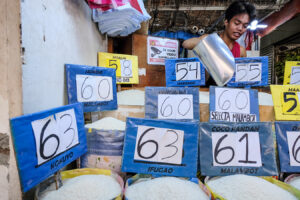




Monthly Economic Update: One for the road
 DOWNLOAD
DOWNLOAD

Inflation Update: Still low, still slow
 DOWNLOAD
DOWNLOAD

Philippines Trade Update: Exports momentum continues
 DOWNLOAD
DOWNLOAD


BSP sees 3.4-4.2% inflation for March

Headline inflation likely further accelerated in March and might have even breached the target for the first time in three months, the Bangko Sentral ng Pilipinas (BSP) said.
Inflation likely settled within 3.4% to 4.2%, the central bank said in a statement on Monday.
The upper end of the BSP’s forecast could have exceeded the 2-4% target for the first time in three months.
The lower end of the forecast would be unchanged from 3.4% in February.
Year on year, inflation would be slower than 7.6% a year earlier.
A BusinessWorld poll of 17 analysts yielded a median estimate of 3.8% for March inflation, within the BSP’s forecast.
“Continued price increases of rice and meat along with higher domestic oil prices and electricity rates are the primary sources of upward price pressures for the month,” the BSP said.
Latest data from the Agriculture department showed that the average retail price of a kilo of local well-milled rice ranged from PHP 49 to PHP 55 as of March 27, higher than PHP 39 to PHP 46 average a year ago. A kilo of regular milled rice costs PHP 50, higher than the PHP 34 to PHP 40 a year ago.
Manila Electric Co. (Meralco) raised the rate for a typical household by PHP 0.0229 to PHP 11.9397 per kilowatt-hour (kWh) in March due to the higher transmission charge.
Fuel prices continued to rise in March. Pump price adjustments stood at a net increase of PHP 2.30 a liter for gasoline and P0.65 a liter each for diesel and kerosene.
“Meanwhile, lower prices of fruits, vegetables, and fish along with the peso appreciation could contribute to downward price pressures,” the BSP said.
The local statistics authority is set to release March inflation data on April 5.
Ruben Carlo O. Asuncion, chief economist at Union Bank of the Philippines, Inc. said inflation might continue to breach the target in the coming months.
“We anticipate headline inflation to surge past 4% year on year starting in March with a hefty contribution from the rice consumer price index (CPI) and latent drought effects on the prices of the other crops, with the worst-case scenario of nearly 5%,” he said in an e-mail.
In February, rice inflation surged to 23.7%, the fastest since 24.6% in February 2009.
Mr. Asuncion said his estimates show that inflation could peak at 5% in May.
Colegio de San Juan de Letran Graduate School Associate Professor Emmanuel J. Lopez in an e-mail said inflation could accelerate in March amid elevated petroleum prices and effects from the El Niño dry spell.
An uptick in inflation could prompt the central bank to keep rates higher for longer.
“As mentioned by the BSP, Finance Secretary Ralph G. Recto, and even the President himself, the central bank will likely take its time before loosening the monetary reins,” Aris D. Dacanay, HSBC economist for ASEAN (Association of Southeast Asian Nations), said in an e-mail.
“Inflation risks are still too tilted to the upside while strong growth grants the central bank the luxury to keep its policy rate high for longer,” he added.
President Ferdinand R. Marcos, Jr. earlier this month said inflation is still the country’s biggest problem and that it might be too soon to cut rates.
To tame inflation, the BSP kept its benchmark rate steady at a near 17-year high of 6.5% for a third-straight meeting in February. It raised borrowing costs by 450 basis points (bps) from May 2022 to October 2023.
The Monetary Board will hold its next policy review on April 8. – Luisa Maria Jacinta C. Jocson, Reporter
This article originally appeared on bworldonline.com





 By BusinessWorld
By BusinessWorld